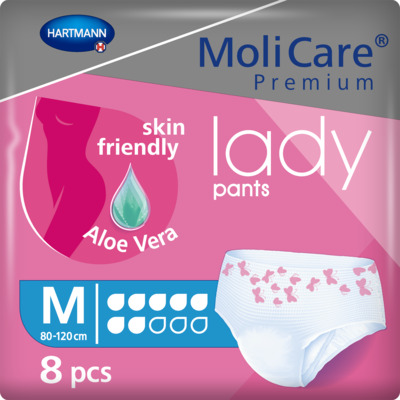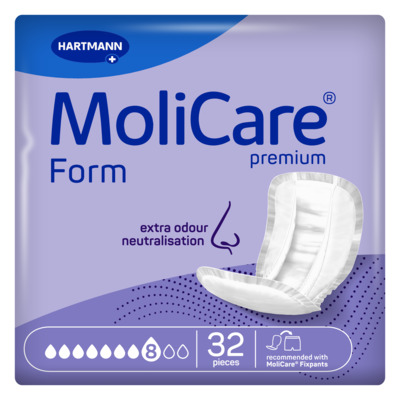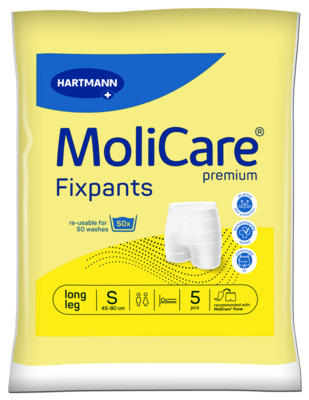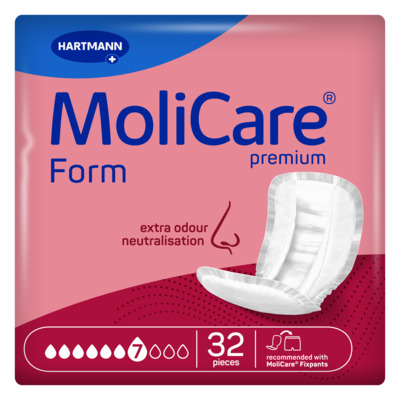Incontinence Advice
Managing Incontinence During Menopause
The menopause is a natural phase in a woman's life, which can often bring unexpected challenges. One such challenge is bladder weakness or incontinence, an issue many may not talk about openly. While the connection between menopause and bladder control isn't always discussed openly, it's a reality for many women. In this article, we will give you all the information that you need to know about managing incontinence during menopause and offer tips on how to manage and navigate the condition.

Understanding Incontinence in Menopause
Incontinence is not just about the involuntary leakage of urine; it's about the loss of control and the accompanying emotional distress. The decline in oestrogen during menopause affects the urinary tract, leading to the thinning of the urethra lining, reduced bladder elasticity, and weakened pelvic muscles.
Menopausal Effects
While many consider menopause to be associated with hot flushes and mood swings, it also affects the urinary tract and bladder, and can easily be overlooked. Remarkably, up to 50% of post-menopausal women can face occasional urine leakage. Therefore, it is vital to understand the reasons behind this and look into potential treatments that can help the changes during menopause.
Why Menopause Can Lead to Incontinence and Bladder Challenges
We understand that menopause can cause a reduction of oestrogen production, a hormone vital for the health of the bladder and urinary tract. This decline can manifest as vaginal dryness, increased urinary frequency, urgency, and occasional leakage, all of which can lead to "genitourinary syndrome of menopause" (GSM).
Notably, while 40-60% of postmenopausal women may encounter GSM, a limited number actively pursue treatment. Let's look at the various incontinence types linked to menopause and GSM.
Managing incontinence during menopause
- Incontinence in Menopause
- Sources
- Why Menopause Can Lead to Incontinence and Bladder Challenges
- Types of Incontinence
- Stress Incontinence
- How to Manage Incontinence during Menopause
- Hormone Replacement Therapy and Incontinence
- Risk Factor Assessment
- How to Treat Bladder Weakness During Menopause
- The Role of Weight in Incontinence
- Treatment Options for Urge and Stress Incontinence
- Manage Incontinence Now
- FAQs
Understanding Incontinence in Menopause
Approximately 30-40% of women will be affected by bladder weakness due to menopause, with the number increasing to 50% for postmenopausal women. Pregnancy in the past also plays a vital role too; women who have given birth tend to be more susceptible than those who haven't.
Factors such as weight, alcohol and caffeine intake, and specific medications can elevate the risk of urinary incontinence. Additionally, urinary tract infections (UTIs) may lead to temporary episodes of incontinence.

Types of Incontinence Linked to Menopause
In this section, we will look at the types of incontinence that are linked to menopause in women. Understanding the differences between these variations will help you to better understand how each type of incontinence works, and the symptoms that are underlined with them.
Stress Incontinence
If you have stress incontinence, you may experience urine leakage when you cough, sneeze, laugh, jump, or lift certain objects.
Learn more about stress incontinence in women to develop a better understanding of this form of incontinence.
Urge Incontinence
Another common form of incontinence is known as urge incontinence and can occur when you have a frequent or urgent need to urinate. This can also be affected by waking up multiple times during the night; this is often referred to as nocturnal enuresis.
Mixed Incontinence
As the name suggests, this is a combination of both stress and urge incontinence. Women experiencing mixed incontinence face challenges from both fronts, making it particularly distressing.
How to Manage Incontinence during Menopause
Whilst managing incontinence, menopause might bring other symptoms such as vaginal prolapse or anxiety. While there are temporary solutions, they might not be viable in the long run. It's best to consult your GP.
- Plan Ahead: Before heading out, familiarise yourself with the locations of nearby public toilets. Always keep a change of product on hand for public toilets.
- Opt for Absorbent Products: MoliCare® offers highly absorbent pads and underwear to manage leaks, especially during physical activities. Modern underwear designs combine style with functionality. We offer plenty of incontinence products for women and incontinence pants.
- Safeguard Your Bed: Consider purchasing bed mats, and either washable or disposable absorbent sheets online. Be sure to check out our page on incontinence bed protection to protect your bed from all forms of incontinence.
Hormone Replacement Therapy (HRT) and Incontinence
Hormone Replacement Therapy (HRT) can replenish the loss of oestrogen levels during menopause, potentially alleviating incontinence symptoms. However, it's not a one-size-fits-all solution. The decision to use HRT should be based on each symptom, medical history, and potential risks. Some studies suggest that HRT might exacerbate incontinence in some women, so it's crucial to have an open discussion with your GP first before deciding.
Risk Factor Assessment
While menopause can lead to bladder issues, combining it with certain conditions can heighten the risk of urinary incontinence.
Alcohol & Caffeine Consumption: Drinks containing alcohol or caffeine can stimulate the bladder, leading to frequent urination. Limiting your intake of these liquids will decrease the risk of having urinary incontinence.
Infections: Urinary tract or bladder infections might result in temporary incontinence. Once the infection is treated, symptoms often diminish or disappear.
Nerve Damage: Damage to nerves can disrupt communication between the bladder and brain, affecting the sensation of needing to urinate and impacting bladder control.
Specific Medications: Some drugs, including diuretics and steroids, might have incontinence as a side effect.
Constipation: Persistent constipation can influence bladder function and weaken pelvic muscles, complicating urine retention.
Excess Weight: Being overweight can elevate the risk due to added pressure on the bladder, potentially initiating or exacerbating incontinence.
How to Treat Bladder Weakness During Menopause
1. Pelvic Floor Exercises:
Daily pelvic floor exercises can enhance bladder control during menopause.
2. Bladder Training:
Schedule bathroom visits throughout the day. This helps in gradually increasing your bladder's capacity.
3. Lifestyle Adjustments:
- Reduce caffeine and alcohol intake; they increase urination.
- Ensure you drink the right amount of water.
- Shedding extra weight can lessen the strain on your bladder and pelvic area.
- Understand the importance of a healthy menopausal lifestyle for better bladder control by knowing about the best bladder friendly drinks.

The Role of Weight in Incontinence
Weight plays a more significant role than most realise in managing incontinence during menopause. Excess weight, especially around the abdominal area, exerts additional pressure on the bladder and pelvic floor muscles. This added pressure can exacerbate incontinence symptoms.
By adopting a balanced diet, engaging in regular physical activity, and losing those extra pounds, you can significantly reduce the risk of incontinence episodes.
Treatment Options for Urge and Stress Incontinence
Many women face the challenges of urgency and frequent urination, disrupting their daily routines. Whilst there are incontinence pads for women, there are also medicinal and surgical solutions available.
Medication for Urge Incontinence:
For those troubled by constant urination urges, antimuscarinic drugs might be the answer. These bladder relaxants can offer relief, especially when combined with pelvic floor exercises and bladder training. Always discuss potential side effects with your doctor.
Surgical Procedures for Urge Incontinence:
If traditional treatments don't alleviate urge incontinence, surgical options might be considered:
- Botulinum Toxin A Injections: Botox injections into the bladder walls can calm overactive muscles. Their effects can last months, with the option for further treatments if required.
- Sacral Nerve Stimulation / Posterior Tibial Nerve Stimulation: This method uses electrical currents on bladder-controlling nerves to manage the bladder muscle. While effective, it's less common due to the success of non-surgical treatments.
Surgical Procedures for Stress Incontinence:
Stress incontinence, or urine leakage during physical activities, can often be managed by strengthening pelvic floor muscles. If symptoms persist, surgical interventions might be explored:
- Colposuspension: This surgical procedure involves lifting the neck of the bladder and stitching it in place. By repositioning the bladder neck, it offers long-term relief from stress incontinence.
- Sling Surgery: Here, a supportive sling, crafted from human or animal tissue or even synthetic materials, is placed around the bladder neck. This acts as a hammock, supporting the bladder and preventing unintentional leakage.
- Urethral Bulking Agents: These agents, when injected, bulk up the urethra walls. By enhancing its size, they ensure the urethra closes more effectively, reducing episodes of leakage.
Skin Care Products
Explore our skin care products now
Multiple Approaches for Managing Incontinence Throughout Menopause:
In summary, there are many ways to manage incontinence during menopause. It requires a multifaceted approach, since women can benefit differently from each option laid out throughout this article, including bladder control training and medication. If symptoms persist, surgical options, ranging from Botox injections to sling surgery, offer viable solutions. It's crucial to consult with your GP to determine the most suitable treatment.
FAQs
What causes incontinence during menopause?
The decrease in oestrogen during menopause can lead to the thinning of the urethra lining, weakening of the pelvic muscles, and reduced bladder elasticity, all of which can contribute to incontinence.
Are there exercises that can help with incontinence?
Answer: Yes, pelvic floor exercises, often referred to as Kegel exercises, can strengthen the muscles that support the bladder and improve bladder control.
Can hormone replacement therapy (HRT) help with incontinence during menopause?
Some women find relief from incontinence symptoms with HRT, but it's essential to discuss potential risks and benefits with a doctor.
How does weight affect incontinence during menopause?
Excess weight can put additional pressure on the bladder and pelvic muscles, exacerbating incontinence symptoms. Maintaining a healthy weight can help reduce this risk.
Can lifestyle changes help manage incontinence?
Absolutely. Reducing caffeine and alcohol intake, drinking an appropriate amount of water, and avoiding bladder irritants can help manage symptoms.
Sources

MoliCare® Premium Lady Pants 7 Drops
<h2>Comfort and Confidence</h2> <p>Experience the comfort and confidence of MoliCare® Premium Lady Pants, specially crafted for moderate incontinence. These slimline and discreet incontinence pants feel just like regular underwear, but they offer superior dryness and protection you can trust from MoliCare®.</p> <p>If 7 drops is too much or too little, we still have plenty of other MoliCare® Premium Lady pants, available in different drop capacities, to suit your every incontinence need. Whichever you go for, our Premium Lady Pants provide the ideal support for your moderate incontinence needs, empowering you to carry on with your daily activities worry-free.</p> <h2>Discreet fitting incontinence pants</h2> <p>The Premium Lady Pants are thoughtfully designed with a lower waistline, ensuring a discreet fit under your clothes. The soft, pH-balanced, and breathable material embraces your body, providing maximum comfort. The quick-drying central layered core rapidly absorbs and locks away moisture, keeping you dry and comfortable throughout the day. Additionally, the Aloe Vera treated top sheet safeguards delicate skin.</p> <p>Worried about leaks? Don't be. Our Premium Lady Pants feature elasticated cuffs that protect against leakage, and special neutralisers seal in odours, leaving you feeling confident, dry, and fresh.</p> <p>These incontinence pants cater to active women as well as those with reduced mobility, providing reliable protection against moderate bladder weakness.</p> <h2>Choosing your Size</h2> <p>Measure waist at the largest width between the waist and hips. Select the product size based on the below sizing.</p> <ul> <li>Medium: 31-47 inches (80-120cm)</li> <li>Large: 47-59 inches (100-150cm)</li> </ul> <h2>Fast delivery</h2> <p>Managing incontinence doesn't have to be a hassle. Our delivery service ensures you receive the products you need right at your doorstep. With easy online reordering and fast shipping, we even offer free delivery on orders over £50.</p> <p>If you have any questions or need assistance, our friendly customer service team is here to help. Just give us a call at 0800 028 9470 to discuss your requirements. Discover the comfort, confidence, and convenience of MoliCare® Premium Lady Pants today.</p>
MoliCare® Premium Form 8 Drops
<h2>Dermatologically tested incontinence pads</h2> <p>Experience comfort and protection against bladder weakness with MoliCare® Premium Form 8 Drops Pads. These pads are designed to provide you with exceptional comfort, tailored to your body's shape. Offering a range of absorbencies, they ensure the right level of protection for moderate to very severe incontinence. With elasticated seams to prevent urine from escaping from the side of the pad, these pads provide added security against leakages.</p> <h2>Absorbent Core Technology</h2> <p>At the core of these soft and breathable pads lies MoliCare®'s unique absorbent core technology, which effectively draws moisture away from your body, leaving your skin feeling dry. The soft textile-like backing sheet reduces rustling noise, while integrated odour neutralisers keep you feeling fresh and confident throughout the day. Dermatologically tested, we recommend pairing the MoliCare® Premium Form 8 Drops with our <a href="https://www.hartmanndirect.co.uk/incontinence-products/large-pads-and-fixation-pants" style="color:#0563c1; text-decoration:underline">fixation pants</a> for all-day comfort and security.</p> <h2>Convenient incontinence products</h2> <p>No matter the level of incontinence you experience, MoliCare® Premium Form 8 Drop Pads offer a convenient solution to confidently manage your needs. You can easily order our products online with the assurance of our price match promise and delivery straight to your doorstep. Enjoy free delivery on all orders over £50.</p> <p>If you require further assistance, our knowledgeable customer care team is available to answer any questions you may have. Contact us today at 0800 028 9470 and regain control of your life with MoliCare® Premium Form 8 Drops Pads.</p> <p>*Based on a study conducted among German nursing homes in 2021.</p>
MoliCare® Premium FixPants Long Leg
<h2>Washable Net Fixation Pants</h2> <p>If you are looking for a comfortable and secure way to manage incontinence, MoliCare® Fixpants Long Leg are a great option when worn with large pads. For men and women of different ages, shapes and sizes, this product is the right choice for you. These pants boast a dense fabric structure that combines air-active properties with ladder resistance, ensuring not only reliable support but also maximum comfort throughout the day. MoliCare® Premium Fixpants provide a safe and hygienic hold for MoliCare® Premium Form pads, giving you peace of mind in any situation.</p> <p>For both women and men, these fixation pants are the perfect way to keep large incontinence pads securely in place. Thanks to the two-piece system, you can count on guaranteed secure fixation, allowing you to go about your daily activities with confidence.</p> <p>Crafted from ladder-resistant dense material, these fixpants maintain their durability while preserving the pad's wetness indicator, ensuring you are always aware of its status.</p> <h2>Unparalleled Comfort</h2> <p>Indulge in the unparalleled comfort of these fixpants, featuring a soft waistband, skin-friendly air-active material, and cross-elasticated threads that provide a close fit tailored to your needs.</p> <p>With the added benefit of various leg lengths to choose from, you can experience optimum comfort and find the most suitable fit for your body shape and preferences.</p> <p>MoliCare® Fixpants are your go-to choice for reliable and comfortable fixation pants, ensuring larger incontinence pads remain securely in place. Embrace the confidence and convenience of washable fixpants, designed to provide the best support and fit for your needs. Bid farewell to worries and discomfort, and embrace worry-free and comfortable days with MoliCare® Fixpants.</p> <h2>Choosing your Size</h2> <p>Measure waist at the largest width between the waist and hips. Select the product size based on the below sizing.</p> <p>Sizes go up to 5 x extra large for larger sizing and bariatric users.</p> <ul> <li>Small: 16-32 inches (45-80cm)</li> <li>Medium: 24-40 inches (60-100cm)</li> <li>Large: 32-48 inches (80-120cm)</li> <li>Extra Large (XL): 40-64 inches (100-160cm)</li> <li>Extra Extra Large (XXL): 56-72 inches (140-180cm)</li> <li>Extra Extra Extra Large (XXXL): 63-79 inches (160-200cm)</li> <li>5X Large: 79-94 inches (200-240cm)</li> </ul>
